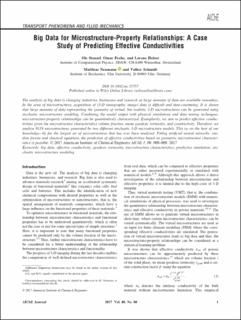Please use this identifier to cite or link to this item:
https://doi.org/10.21256/zhaw-1562| Publication type: | Article in scientific journal |
| Type of review: | Peer review (publication) |
| Title: | Big data for microstructure-property relationships : a case study of predicting effective conductivities |
| Authors: | Stenzel, Ole Pecho, Omar Holzer, Lorenz Neumann, Matthias Schmidt, Volker |
| DOI: | 10.21256/zhaw-1562 10.1002/aic.15757 |
| Published in: | AIChE Journal |
| Volume(Issue): | 63 |
| Issue: | 9 |
| Page(s): | 4224 |
| Pages to: | 4232 |
| Issue Date: | 2017 |
| Publisher / Ed. Institution: | Wiley |
| ISSN: | 1547-5905 0001-1541 |
| Language: | English |
| Subjects: | Map |
| Subject (DDC): | 005: Computer programming, programs and data 530: Physics |
| Abstract: | The analysis of big data is changing industries, businesses and research as large amounts of data are available nowadays. In the area of microstructures, acquisition of (3-D tomographic image) data is difficult and time-consuming. It is shown that large amounts of data representing the geometry of virtual, but realistic 3-D microstructures can be generated using stochastic microstructure modeling. Combining the model output with physical simulations and data mining techniques, microstructure-property relationships can be quantitatively characterized. Exemplarily, we aim to predict effective conductivities given the microstructure characteristics volume fraction, mean geodesic tortuosity, and constrictivity. Therefore, we analyze 8119 microstructures generated by two different stochastic 3-D microstructure models. This is – to the best of our knowledge – by far the largest set of microstructures that has ever been analyzed. Fitting artificial neural networks, random forests and classical equations, the prediction of effective conductivities based on geometric microstructure characteristics is possible. |
| URI: | https://digitalcollection.zhaw.ch/handle/11475/2113 |
| Fulltext version: | Published version |
| License (according to publishing contract): | Licence according to publishing contract |
| Departement: | School of Engineering |
| Organisational Unit: | Institute of Computational Physics (ICP) |
| Appears in collections: | Publikationen School of Engineering |
Files in This Item:
| File | Description | Size | Format | |
|---|---|---|---|---|
| 2017_Stenzel_Big data for microstructure-property relationships_AIChE Journal.pdf | 707.46 kB | Adobe PDF |  View/Open |
Show full item record
Stenzel, O., Pecho, O., Holzer, L., Neumann, M., & Schmidt, V. (2017). Big data for microstructure-property relationships : a case study of predicting effective conductivities. AIChE Journal, 63(9), 4224–4232. https://doi.org/10.21256/zhaw-1562
Stenzel, O. et al. (2017) ‘Big data for microstructure-property relationships : a case study of predicting effective conductivities’, AIChE Journal, 63(9), pp. 4224–4232. Available at: https://doi.org/10.21256/zhaw-1562.
O. Stenzel, O. Pecho, L. Holzer, M. Neumann, and V. Schmidt, “Big data for microstructure-property relationships : a case study of predicting effective conductivities,” AIChE Journal, vol. 63, no. 9, pp. 4224–4232, 2017, doi: 10.21256/zhaw-1562.
STENZEL, Ole, Omar PECHO, Lorenz HOLZER, Matthias NEUMANN und Volker SCHMIDT, 2017. Big data for microstructure-property relationships : a case study of predicting effective conductivities. AIChE Journal. 2017. Bd. 63, Nr. 9, S. 4224–4232. DOI 10.21256/zhaw-1562
Stenzel, Ole, Omar Pecho, Lorenz Holzer, Matthias Neumann, and Volker Schmidt. 2017. “Big Data for Microstructure-Property Relationships : A Case Study of Predicting Effective Conductivities.” AIChE Journal 63 (9): 4224–32. https://doi.org/10.21256/zhaw-1562.
Stenzel, Ole, et al. “Big Data for Microstructure-Property Relationships : A Case Study of Predicting Effective Conductivities.” AIChE Journal, vol. 63, no. 9, 2017, pp. 4224–32, https://doi.org/10.21256/zhaw-1562.
Items in DSpace are protected by copyright, with all rights reserved, unless otherwise indicated.